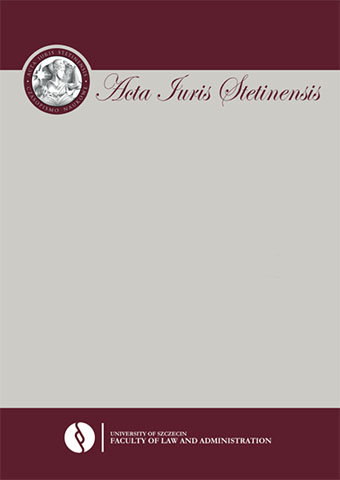







| Authors: |
Łaski
Piotr
Uniwersytet Szczeciński |
| Keywords: | armed-force force public international law reprisal self-defense |
| Data publikacji całości: | 2015 |
| Page range: | 24 (61-84) |
| Downloads ?: | 1383 |
| 1. | Barcik J., Akt terrorystyczny i jego sprawa w świetle prawa międzynarodowego, Warszawa 2004. |
| 2. | Barcik J., Srogosz T., Prawo międzynarodowe publiczne, Warszawa 2014. |
| 3. | Bowett D.W., The Use of Force for the Protection of Nationals Abroad, w: The Current Legal Regulation of the Use of Force, Oxford 1986. |
| 4. | Conuiff M.L., Panama and the United States. The Forced Alliance, Athens 1992.81Uwagi na temat si ły i jej stosowania... |
| 5. | Crawford J., Democracy and International Law, „British Yearbook of International Law” 1993, vol. 44. |
| 6. | Crépon P., Religia a wojna, Gdańsk 1994. |
| 7. | Czapliński W., Wyrozumska A., Prawo międzynarodowe publiczne. Zagadnienia systemowe, Warszawa 2004. |
| 8. | Delbrück J., The Fight Against Global Terrorism: Self-defence or Collective Security as International Police Action? Some Comments on the International Legal Implications of the „War against Terrorism”, „German Yearbook of International Law” 2001, vol. 44 |
| 9. | Diccionario Enciclopedico Abreviado, Madrid 1933, t. 2. |
| 10. | Dictionnaire Quillet de la langue francaise, Paris 1959, t. 1. |
| 11. | Dinstein Y., The Conduct of Hostilities under the law of International Armed Conflict, Cambridge 2004. |
| 12. | Doswald-Beck L., The Legal Validity of Military Intervention by Invitation of the Government, „British Yearbook of International Law” 1985, vol. 56. |
| 13. | Ehrlich L., Interpretacja traktatów, Warszawa 1957. |
| 14. | Frowein J.A., Unilateral Interpretation of Security Council Resolutions – a Threat to Collective Security, w: Liber amicorum Günther Jaenicke, red. V. Götz et al., Berlin–Heidelberg 1998. |
| 15. | Gibney F., Korea’s Quiet Revolution: From Garrison State to Democracy, New York 1992. |
| 16. | Gilmore W., The Grenada Intervention, London 1984. |
| 17. | Gray C., From Unity to Polarization. International Law and the Use of Force against Iraq, „European Journal of International Law” 2002, vol. 12, no. 1. |
| 18. | Green L.C., Rescue at Entebbe – Legal Aspects, „Israel Yearbook of Human Rights” 1976, vol. 6. |
| 19. | Greenwood C., The Twilight of the Law of Belligerent Reprisals, „Netherland Yearbook of International Law” 1989, vol. 20. |
| 20. | Haraszti G., Some Fundamental Problems of the Law of Treaties, Budapest 1973. International Court of Justice Reports 1980, 1986. International Legal Reports 1986. |
| 21. | Jacewicz A., Pojęcie siły w Karcie Narodów Zjednoczonych, Warszawa 1977. |
| 22. | Keegan J., History of Warfare, London 1993. |
| 23. | Kowalski M., Prawo do samoobrony jako środek zwalczania terroryzmu międzynarodowego, Warszawa 2013. |
| 24. | Kranz J., Użycie siły zbrojnej – nowe fakty i tendencje, „Sprawy Międzynarodowe” 2006, nr 3. |
| 25. | Krisiotis D., The Legality of the 1983 US Missile Strike on Iraq and the Right of Self-defence in International Law, „International and Comperative Law Quartely” 1996, vol. 45. |
| 26. | Longman Dictionary of English Laguage and Culture, Oxford 1992. |
| 27. | Mc Lain P., Setting the Score with Saddam: Resolution 1441 and Parallel Justifications for the Use Force Against Iraq, „Duke Journal of Comparative and International Law” 2003, vol. 13, no. 1. |
| 28. | Murphy S.D., Contemporary Practice of the United States Relating to International Law, „American Journal of International Law”, 1999, vol. 93, no. 1. |
| 29. | Murphy S.D., Terrorism and the Concept of „Armed Attack” in Article 51 of the U.N. Charter, „Harvard International Law Journal” 2002, vol. 43. |
| 30. | Nicholls D., From Dessalines to Duvalier: The Race, Colour and National Dependence in Haiti, London 1996. |
| 31. | Pattison J., Humanitarian Intervention and the Responsibility to Protect, Oxford 2012. |
| 32. | Pokempner D., Terrorism and Human Rights: The Legal Framework, w: Terrorism and International Law, red. M. Schmitt, G.L. Berutto, San Remo 2003. |
| 33. | Schweisfurth T., Operations to Rescue Nationals in Third States Involving the Use of Force in Relation to Protection of Human Rights, „German Yearbook of International Law” 1980. |
| 34. | Shaw M.N, Some Legal Aspects of the Entebbe Incident, „Jewish Law Annual” 1978. |
| 35. | Shaw M.N., Prawo międzynarodowe, Warszawa 2011. |
| 36. | Słowar russkogo jazyka w czetyriech tomach, Moskwa 1961, t. 4. |
| 37. | Tomuschart Ch., Der 11 September 2001 und seune rechtlichen konsequenzen, „Europaische Grundrechte-Zeitschriff” 2001, Nr. 28. |
| 38. | Uniwersalny słownik języka polskiego, Warszawa 2003, t. 3. |
| 39. | Wilmshurst E., International Law and the Classification of Conflicts, Oxford 2012. |
| 40. | Wybór dokumentów do nauki prawa międzynarodowego, oprac. K. Kocot, K. Wolfke, Wrocław–Warszawa 1976. |
| 41. | Zajadło J., Dylematy humanitarnej interwencji, Gdańsk 2005 |